SKODA FABIA 2003 1.G / 6Y Owner's Manual
Manufacturer: SKODA, Model Year: 2003, Model line: FABIA, Model: SKODA FABIA 2003 1.G / 6YPages: 233, PDF Size: 32.04 MB
Page 191 of 233
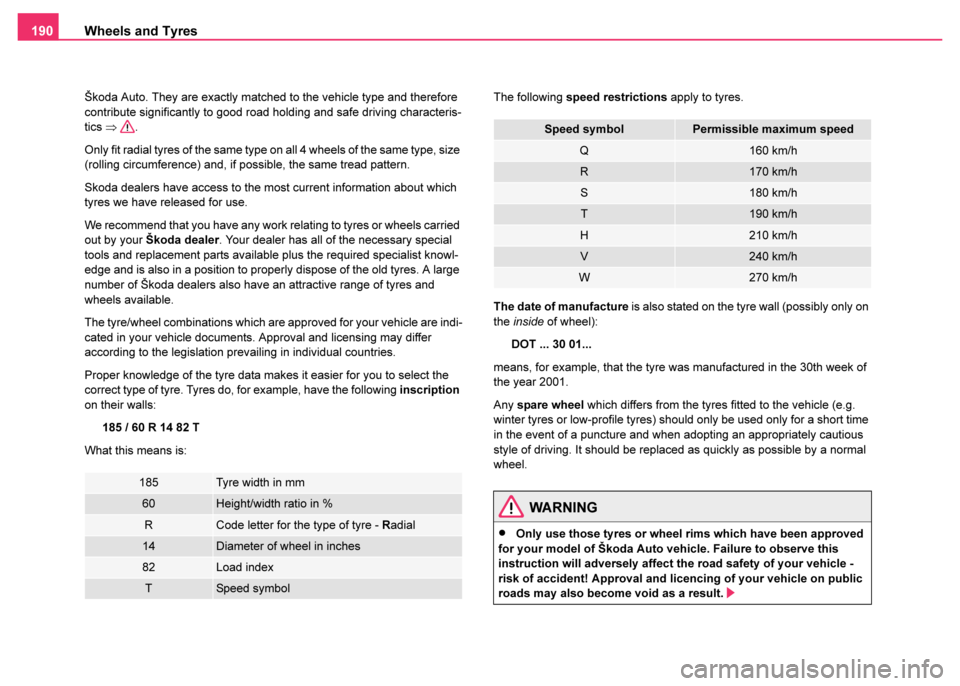
Wheels and Tyres
190
Škoda Auto. They are exactly matched to the vehicle type and therefore
contribute significantly to good road holding and safe driving characteris-
tics ⇒ .
Only fit radial tyres of the same type on all 4 wheels of the same type, size
(rolling circumference) and, if possible, the same tread pattern.
Skoda dealers have access to the most current information about which
tyres we have released for use.
We recommend that you have any work relating to tyres or wheels carried
out by your Škoda dealer . Your dealer has all of the necessary special
tools and replacement parts available plus the required specialist knowl-
edge and is also in a position to properly dispose of the old tyres. A large
number of Škoda dealers also have an attractive range of tyres and
wheels available.
The tyre/wheel combinations which are approved for your vehicle are indi-
cated in your vehicle documents. Approval and licensing may differ
according to the legislation prevailing in individual countries.
Proper knowledge of the tyre data makes it easier for you to select the
correct type of tyre. Tyres do, for example, have the following inscription
on their walls:
185 / 60 R 14 82 T
What this means is: The following speed restrictions
apply to tyres.
The date of manufacture is also stated on the tyre wall (possibly only on
the inside of wheel):
DOT ... 30 01...
means, for example, that the tyre was manufactured in the 30th week of
the year 2001.
Any spare wheel which differs from the tyres fitted to the vehicle (e.g.
winter tyres or low-profile tyres) should only be used only for a short time
in the event of a puncture and when adopting an appropriately cautious
style of driving. It should be replaced as quickly as possible by a normal
wheel.
185Tyre width in mm
60Height/width ratio in %
RCode letter for the type of tyre - Radial
14Diameter of wheel in inches
82Load index
TSpeed symbol
Speed symbolPermissible maximum speed
Q160 km/h
R170 km/h
S180 km/h
T190 km/h
H210 km/h
V240 km/h
W270 km/h
WARNING
•Only use those tyres or wheel rims which have been approved
for your model of Škoda Auto vehicle. Failure to observe this
instruction will adversely affect the road safety of your vehicle -
risk of accident! Approval and licencing of your vehicle on public
roads may also become void as a result.
Page 192 of 233
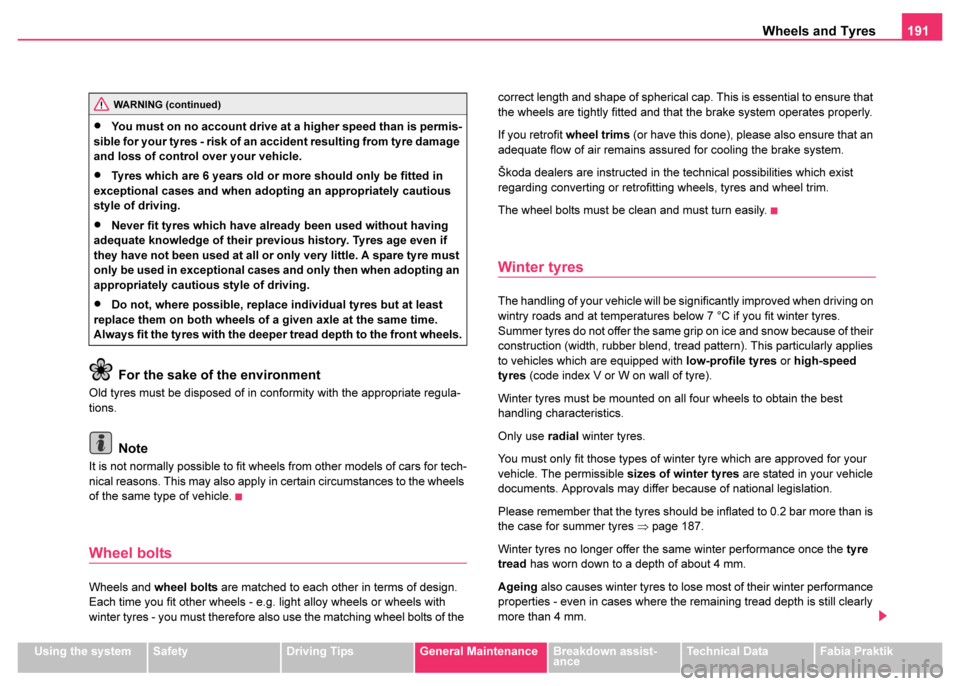
Wheels and Tyres191
Using the systemSafetyDriving TipsGeneral MaintenanceBreakdown assist-
anceTechnical DataFabia Praktik
For the sake of the environment
Old tyres must be disposed of in conformity with the appropriate regula-
tions.
Note
It is not normally possible to fit wheels from other models of cars for tech-
nical reasons. This may also apply in certain circumstances to the wheels
of the same type of vehicle.
Wheel bolts
Wheels and wheel bolts are matched to each other in terms of design.
Each time you fit other wheels - e.g. light alloy wheels or wheels with
winter tyres - you must therefore also use the matching wheel bolts of the correct length and shape of spherical cap. This is essential to ensure that
the wheels are tightly fitted and that the brake system operates properly.
If you retrofit
wheel trims (or have this done), please also ensure that an
adequate flow of air remains assured for cooling the brake system.
Škoda dealers are instructed in the technical possibilities which exist
regarding converting or retrofitting wheels, tyres and wheel trim.
The wheel bolts must be clean and must turn easily.
Winter tyres
The handling of your vehicle will be significantly improved when driving on
wintry roads and at temperatures below 7 °C if you fit winter tyres.
Summer tyres do not offer the same grip on ice and snow because of their
construction (width, rubber blend, tread pattern). This particularly applies
to vehicles which are equipped with low-profile tyres or high-speed
tyres (code index V or W on wall of tyre).
Winter tyres must be mounted on all four wheels to obtain the best
handling characteristics.
Only use radial winter tyres.
You must only fit those types of winter tyre which are approved for your
vehicle. The permissible sizes of winter tyres are stated in your vehicle
documents. Approvals may differ because of national legislation.
Please remember that the tyres should be inflated to 0.2 bar more than is
the case for summer tyres ⇒page 187.
Winter tyres no longer offer the same winter performance once the tyre
tread has worn down to a depth of about 4 mm.
Ageing also causes winter tyres to lose most of their winter performance
properties - even in cases where the remaining tread depth is still clearly
more than 4 mm.
WARNING (continued)
•You must on no account drive at a higher speed than is permis-
sible for your tyres - risk of an accident resulting from tyre damage
and loss of control over your vehicle.
•Tyres which are 6 years old or more should only be fitted in
exceptional cases and when adopting an appropriately cautious
style of driving.
•Never fit tyres which have already been used without having
adequate knowledge of their previous history. Tyres age even if
they have not been used at all or only very little. A spare tyre must
only be used in exceptional cases and only then when adopting an
appropriately cautious style of driving.
•Do not, where possible, replace individual tyres but at least
replace them on both wheels of a given axle at the same time.
Always fit the tyres with the deeper tread depth to the front wheels.
Page 193 of 233
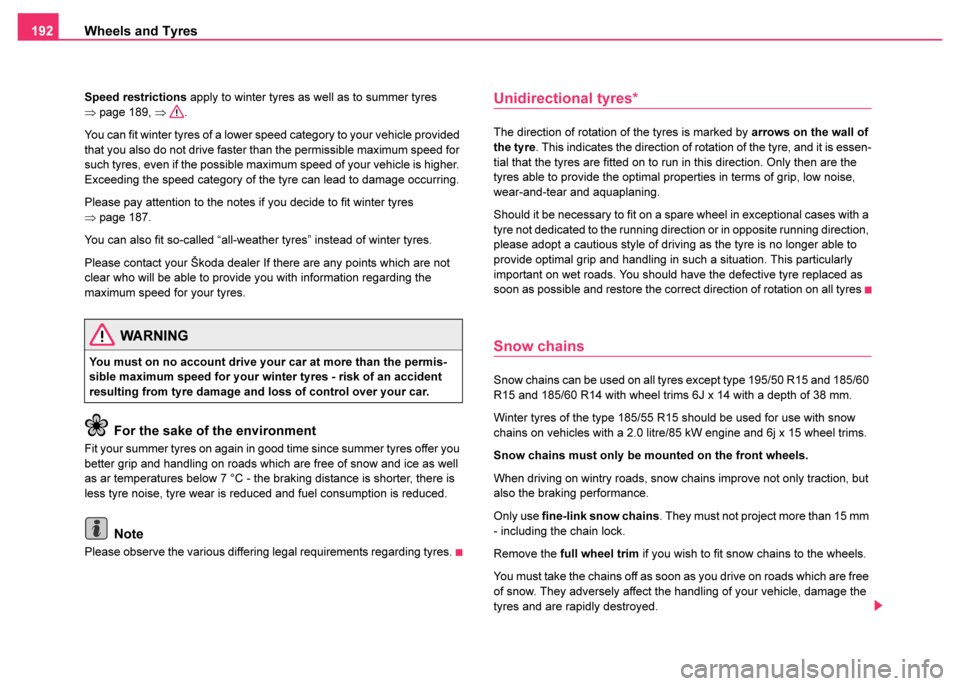
Wheels and Tyres
192
Speed restrictions apply to winter tyres as well as to summer tyres
⇒ page 189, ⇒.
You can fit winter tyres of a lower speed category to your vehicle provided
that you also do not drive faster than the permissible maximum speed for
such tyres, even if the possible maximum speed of your vehicle is higher.
Exceeding the speed category of the tyre can lead to damage occurring.
Please pay attention to the notes if you decide to fit winter tyres
⇒ page 187.
You can also fit so-called “all-weather tyres” instead of winter tyres.
Please contact your Škoda dealer If there are any points which are not
clear who will be able to provide you with information regarding the
maximum speed for your tyres.
For the sake of the environment
Fit your summer tyres on again in good time since summer tyres offer you
better grip and handling on roads which are free of snow and ice as well
as ar temperatures below 7 °C - the braking distance is shorter, there is
less tyre noise, tyre wear is reduced and fuel consumption is reduced.
Note
Please observe the various differing legal requirements regarding tyres.
Unidirectional tyres*
The direction of rotation of the tyres is marked by arrows on the wall of
the tyre . This indicates the direction of rotation of the tyre, and it is essen-
tial that the tyres are fitted on to run in this direction. Only then are the
tyres able to provide the optimal properties in terms of grip, low noise,
wear-and-tear and aquaplaning.
Should it be necessary to fit on a spare wheel in exceptional cases with a
tyre not dedicated to the running direction or in opposite running direction,
please adopt a cautious style of driving as the tyre is no longer able to
provide optimal grip and handling in such a situation. This particularly
important on wet roads. You should have the defective tyre replaced as
soon as possible and restore the correct direction of rotation on all tyres
Snow chains
Snow chains can be used on all tyres except type 195/50 R15 and 185/60
R15 and 185/60 R14 with wheel trims 6J x 14 with a depth of 38 mm.
Winter tyres of the type 185/55 R15 should be used for use with snow
chains on vehicles with a 2.0 litre/85 kW engine and 6j x 15 wheel trims.
Snow chains must only be mounted on the front wheels.
When driving on wintry roads, snow chains improve not only traction, but
also the braking performance.
Only use fine-link snow chains . They must not project more than 15 mm
- including the chain lock.
Remove the full wheel trim if you wish to fit snow chains to the wheels.
You must take the chains off as soon as you drive on roads which are free
of snow. They adversely affect the handling of your vehicle, damage the
tyres and are rapidly destroyed.
WARNING
You must on no account drive your car at more than the permis-
sible maximum speed for your winter tyres - risk of an accident
resulting from tyre damage and loss of control over your car.
Page 194 of 233
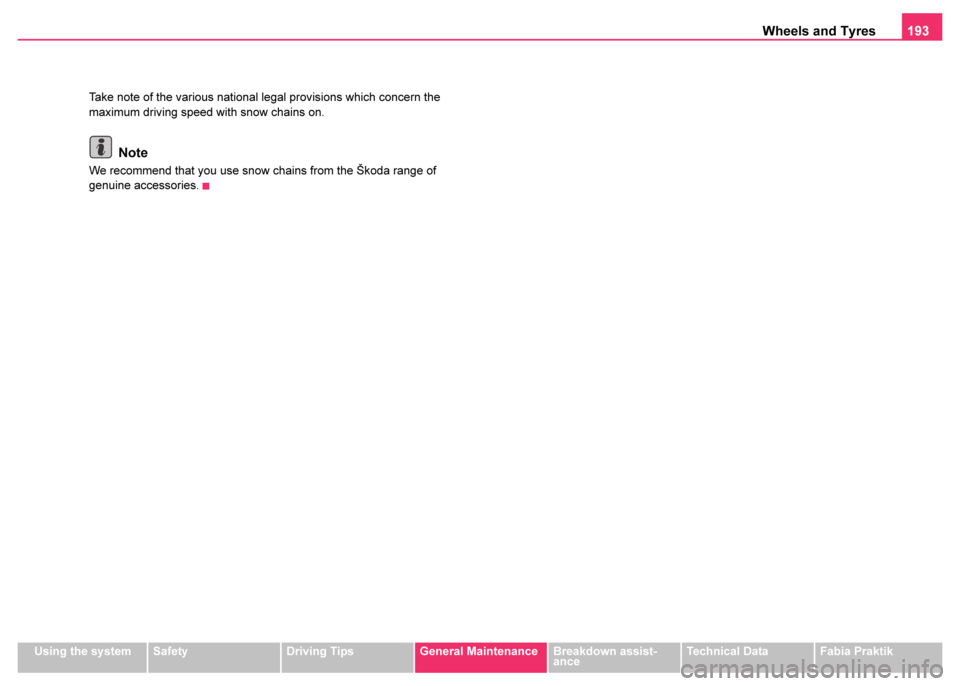
Wheels and Tyres193
Using the systemSafetyDriving TipsGeneral MaintenanceBreakdown assist-
anceTechnical DataFabia Praktik
Take note of the various national legal provisions which concern the
maximum driving speed with snow chains on.
Note
We recommend that you use snow chains from the Škoda range of
genuine accessories.
Page 195 of 233
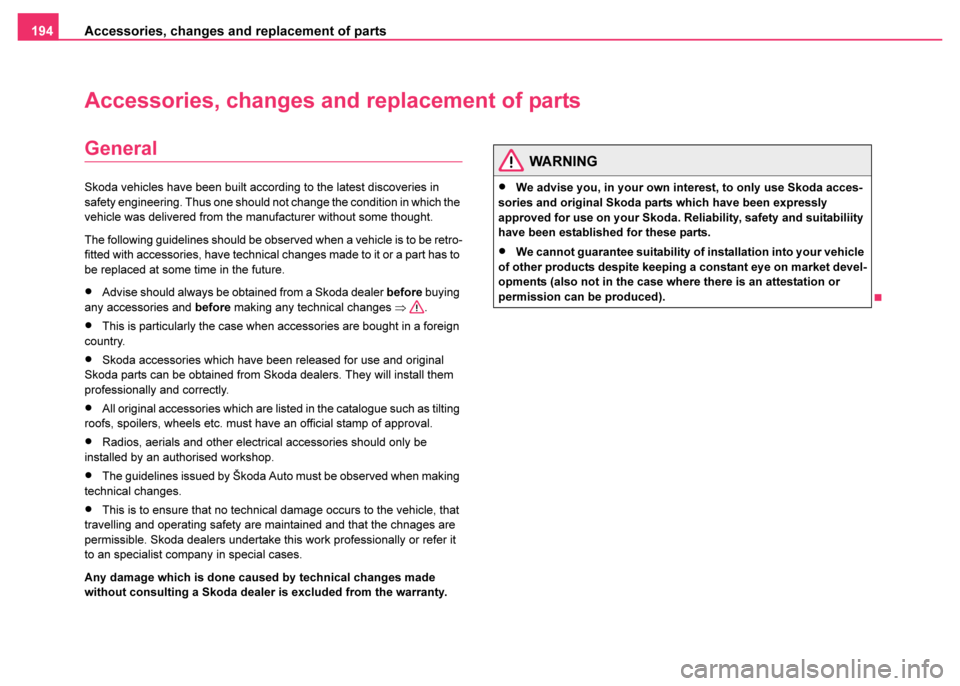
Accessories, changes and replacement of parts
194
Accessories, changes and replacement of parts
General
Skoda vehicles have been built according to the latest discoveries in
safety engineering. Thus one should not change the condition in which the
vehicle was delivered from the manufacturer without some thought.
The following guidelines should be observed when a vehicle is to be retro-
fitted with accessories, have technical changes made to it or a part has to
be replaced at some time in the future.
•Advise should always be obtained from a Skoda dealer before buying
any accessories and before making any technical changes ⇒.
•This is particularly the case when accessories are bought in a foreign
country.
•Skoda accessories which have been released for use and original
Skoda parts can be obtained from Skoda dealers. They will install them
professionally and correctly.
•All original accessories which are listed in the catalogue such as tilting
roofs, spoilers, wheels etc. must have an official stamp of approval.
•Radios, aerials and other electrical accessories should only be
installed by an authorised workshop.
•The guidelines issued by Škoda Auto must be observed when making
technical changes.
•This is to ensure that no technical damage occurs to the vehicle, that
travelling and operating safety are maintained and that the chnages are
permissible. Skoda dealers undertake this work professionally or refer it
to an specialist company in special cases.
Any damage which is done caused by technical changes made
without consulting a Skoda dealer is excluded from the warranty.
WARNING
•We advise you, in your own interest, to only use Skoda acces-
sories and original Skoda parts which have been expressly
approved for use on your Skoda. Reliability, safety and suitabiliity
have been established for these parts.
•We cannot guarantee suitability of installation into your vehicle
of other products despite keeping a constant eye on market devel-
opments (also not in the case where there is an attestation or
permission can be produced).
Page 196 of 233
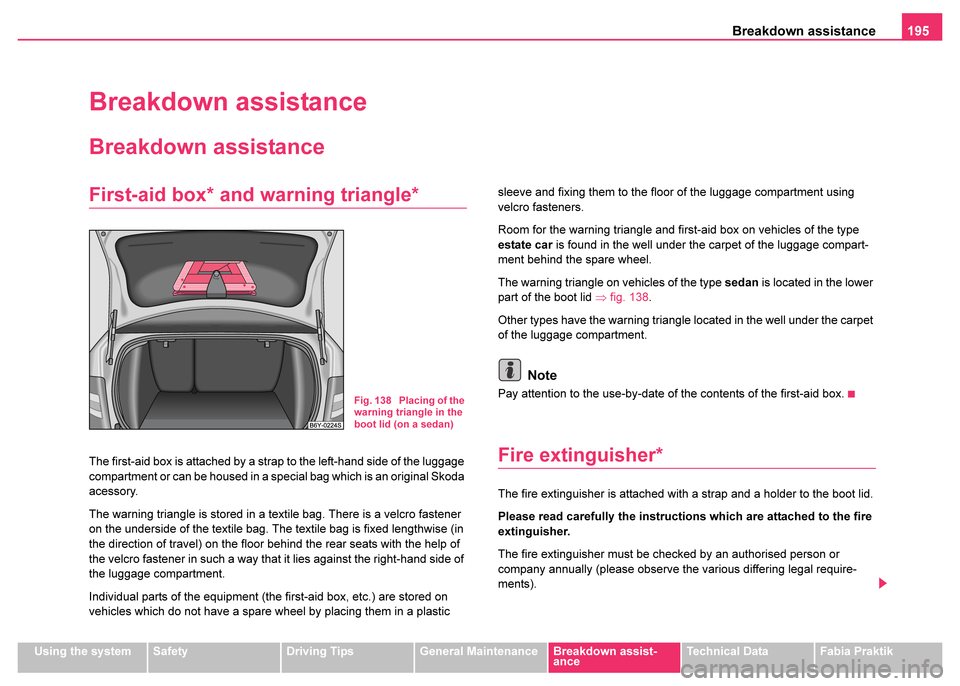
Breakdown assistance195
Using the systemSafetyDriving TipsGeneral MaintenanceBreakdown assist-
anceTechnical DataFabia Praktik
Breakdown assistance
Breakdown assistance
First-aid box* and warning triangle*
The first-aid box is attached by a strap to the left-hand side of the luggage
compartment or can be housed in a special bag which is an original Skoda
acessory.
The warning triangle is stored in a textile bag. There is a velcro fastener
on the underside of the textile bag. The textile bag is fixed lengthwise (in
the direction of travel) on the floor behind the rear seats with the help of
the velcro fastener in such a way that it lies against the right-hand side of
the luggage compartment.
Individual parts of the equipment (the first-aid box, etc.) are stored on
vehicles which do not have a spare wheel by placing them in a plastic sleeve and fixing them to the floor of the luggage compartment using
velcro fasteners.
Room for the warning triangle and first-aid box on vehicles of the type
estate car
is found in the well under the carpet of the luggage compart-
ment behind the spare wheel.
The warning triangle on vehicles of the type sedan is located in the lower
part of the boot lid ⇒fig. 138.
Other types have the warning triangle located in the well under the carpet
of the luggage compartment.
Note
Pay attention to the use-by-date of the contents of the first-aid box.
Fire extinguisher*
The fire extinguisher is attached with a strap and a holder to the boot lid.
Please read carefully the instructions which are attached to the fire
extinguisher.
The fire extinguisher must be checked by an authorised person or
company annually (please observe the various differing legal require-
ments).
Fig. 138 Placing of the
warning triangle in the
boot lid (on a sedan)
Page 197 of 233

Breakdown assistance
196
Note
The fire extinguisher is only supplied in certain countries within the scope
of delivery.
Vehicle tool kit
The vehicle tool kit and the lifting jack are stored in a locable plastic box
in the spare wheel ⇒ fig. 139. There is also space here for the removable
ball for the trailer towing device*.
The vehicle tool kit contains the following parts (depending on equipment
fitted):
•Wheel wrench
•Hook for pulling off a full wheel trim
•To w i n g e y e
•Adapter for the wheel bolts lock
After using the lifting jack, screw in the arm of the lifting jack fully before
placing it back in its stowage area.
Spray for repairing a tyre*
The spray for repairing a tyre is intended for rapid repair of small defects
in a tyre consisting of a damage up to a size of up to 5 mm. The spray is
not at all intended to replace a permanent repair on the tyre; this repair
only serves to reach the next workshop. The repair can be undertaken on
Fig. 139 Luggage
compartment: Storage
compartment for
vehicle too kit
WARNING
The factory-supplied lifting jack is only intended for your model of
vehicle. On no account attempt to lift a heavier vehicle or other
loads - risk of injury!
Fig. 140 Spray for
repairing a tyre
Page 198 of 233
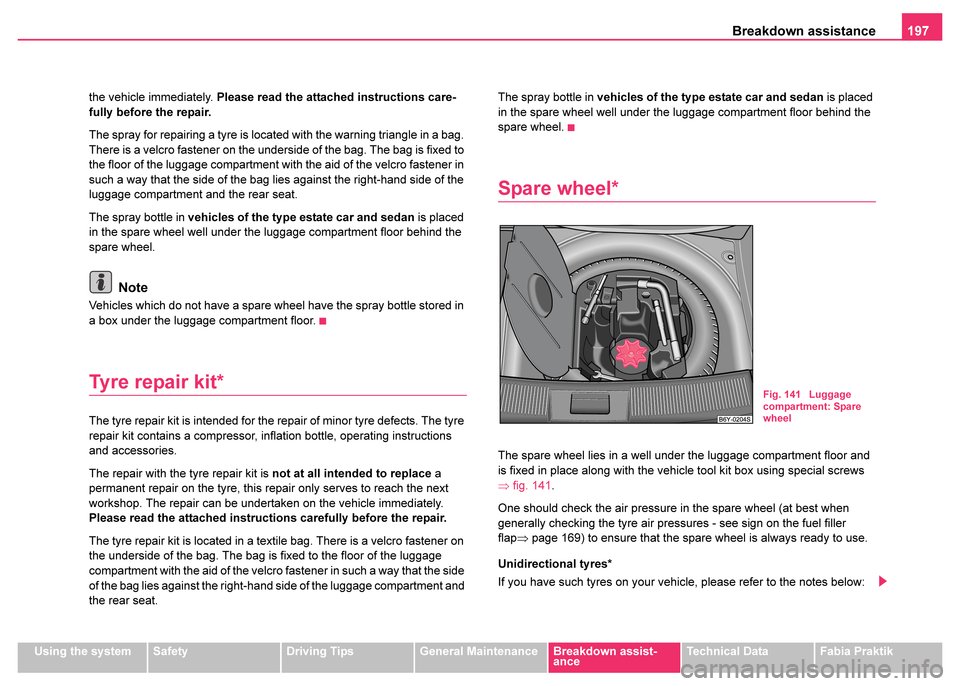
Breakdown assistance197
Using the systemSafetyDriving TipsGeneral MaintenanceBreakdown assist-
anceTechnical DataFabia Praktik
the vehicle immediately.
Please read the attached instructions care-
fully before the repair.
The spray for repairing a tyre is located with the warning triangle in a bag.
There is a velcro fastener on the underside of the bag. The bag is fixed to
the floor of the luggage compartment with the aid of the velcro fastener in
such a way that the side of the bag lies against the right-hand side of the
luggage compartment and the rear seat.
The spray bottle in vehicles of the type estate car and sedan is placed
in the spare wheel well under the luggage compartment floor behind the
spare wheel.
Note
Vehicles which do not have a spare wheel have the spray bottle stored in
a box under the luggage compartment floor.
Tyre repair kit*
The tyre repair kit is intended for the repair of minor tyre defects. The tyre
repair kit contains a compressor, inflation bottle, operating instructions
and accessories.
The repair with the tyre repair kit is not at all intended to replace a
permanent repair on the tyre, this repair only serves to reach the next
workshop. The repair can be undertaken on the vehicle immediately.
Please read the attached instructions carefully before the repair.
The tyre repair kit is located in a textile bag. There is a velcro fastener on
the underside of the bag. The bag is fixed to the floor of the luggage
compartment with the aid of the velcro fastener in such a way that the side
of the bag lies against the right-hand side of the luggage compartment and
the rear seat. The spray bottle in
vehicles of the type estate car and sedan is placed
in the spare wheel well under the luggage compartment floor behind the
spare wheel.
Spare wheel*
The spare wheel lies in a well under the luggage compartment floor and
is fixed in place along with the vehicle tool kit box using special screws
⇒ fig. 141 .
One should check the air pressure in the spare wheel (at best when
generally checking the tyre air pressures - see sign on the fuel filler
flap ⇒page 169) to ensure that the spare wheel is always ready to use.
Unidirectional tyres*
If you have such tyres on your vehicle, please refer to the notes below:
Fig. 141 Luggage
compartment: Spare
wheel
Page 199 of 233
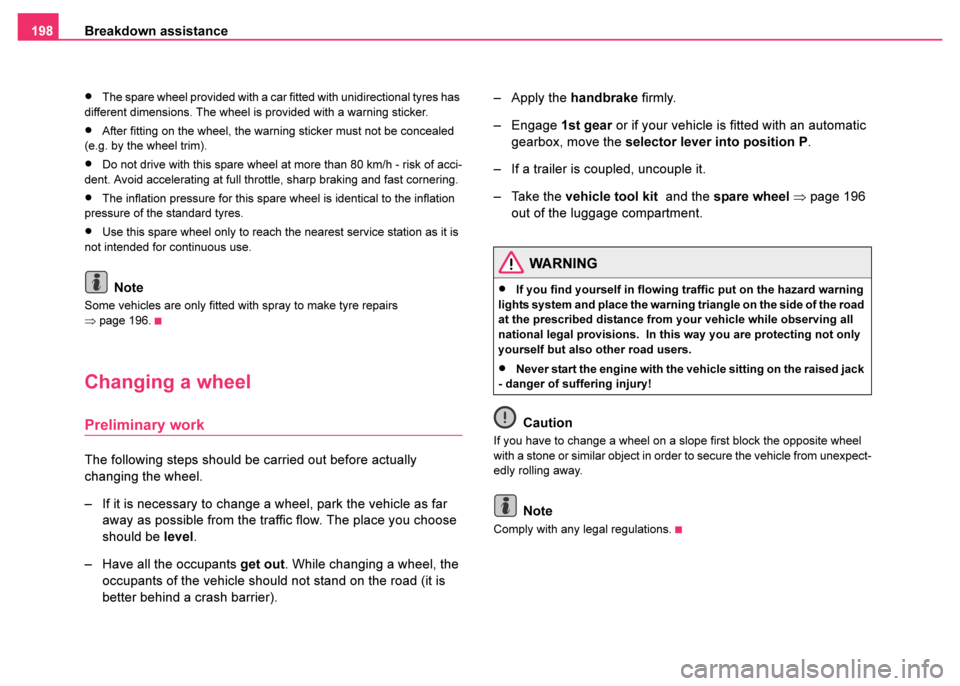
Breakdown assistance
198
•The spare wheel provided with a car fitted with unidirectional tyres has
different dimensions. The wheel is provided with a warning sticker.
•After fitting on the wheel, the warning sticker must not be concealed
(e.g. by the wheel trim).
•Do not drive with this spare wheel at more than 80 km/h - risk of acci-
dent. Avoid accelerating at full throttle, sharp braking and fast cornering.
•The inflation pressure for this spare wheel is identical to the inflation
pressure of the standard tyres.
•Use this spare wheel only to reach the nearest service station as it is
not intended for continuous use.
Note
Some vehicles are only fitted with spray to make tyre repairs
⇒ page 196.
Changing a wheel
Preliminary work
The following steps should be carried out before actually
changing the wheel.
– If it is necessary to change a wheel, park the vehicle as far
away as possible from the traffic flow. The place you choose
should be level.
– Have all the occupants get out. While changing a wheel, the
occupants of the vehicle should not stand on the road (it is
better behind a crash barrier). – Apply the
handbrake firmly.
– Engage 1st gear or if your vehicle is fitted with an automatic
gearbox, move the selector lever into position P .
– If a trailer is coupled, uncouple it.
– Take the vehicle tool kit and the spare wheel ⇒ page 196
out of the luggage compartment.
Caution
If you have to change a wheel on a slope first block the opposite wheel
with a stone or similar object in order to secure the vehicle from unexpect-
edly rolling away.
Note
Comply with any legal regulations.
WARNING
•If you find yourself in flowing traffic put on the hazard warning
lights system and place the warning triangle on the side of the road
at the prescribed distance from your vehicle while observing all
national legal provisions. In this way you are protecting not only
yourself but also other road users.
•Never start the engine with the vehicle sitting on the raised jack
- danger of suffering injury!
Page 200 of 233
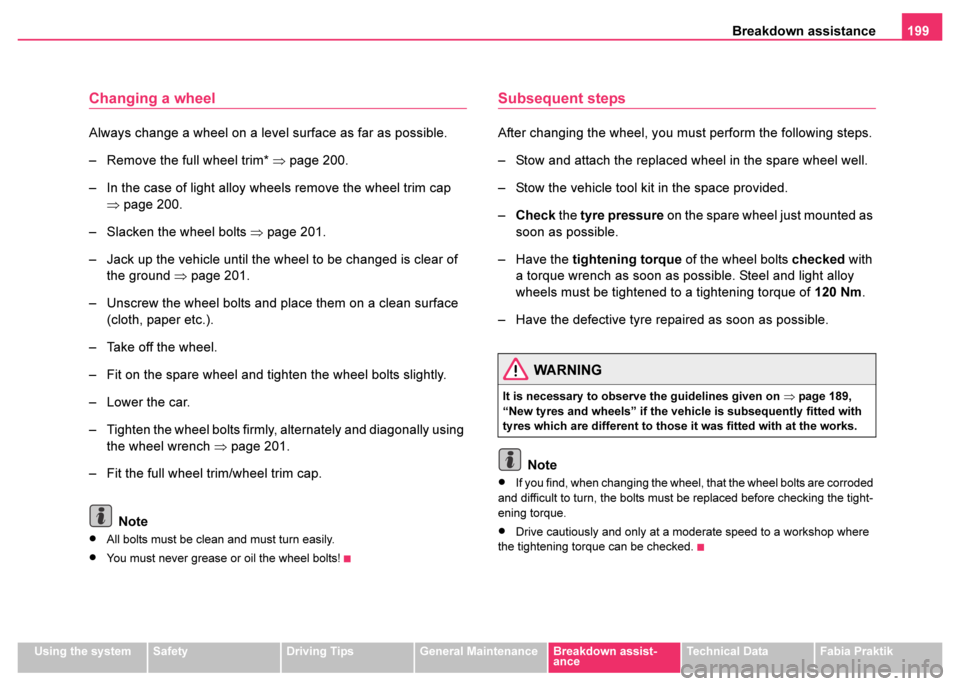
Breakdown assistance199
Using the systemSafetyDriving TipsGeneral MaintenanceBreakdown assist-
anceTechnical DataFabia Praktik
Changing a wheel
Always change a wheel on a leve l surface as far as possible.
– Remove the full wheel trim* ⇒page 200.
– In the case of light alloy wheels remove the wheel trim cap ⇒page 200.
– Slacken the wheel bolts ⇒page 201.
– Jack up the vehicle until the wheel to be changed is clear of the ground ⇒page 201.
– Unscrew the wheel bolts and place them on a clean surface (cloth, paper etc.).
– Take off the wheel.
– Fit on the spare wheel and tighten the wheel bolts slightly.
– Lower the car.
– Tighten the wheel bolts firmly, alternately and diagonally using the wheel wrench ⇒page 201.
– Fit the full wheel trim/wheel trim cap.
Note
•All bolts must be clean and must turn easily.
•You must never grease or oil the wheel bolts!
Subsequent steps
After changing the wheel, you must perform the following steps.
– Stow and attach the replaced wheel in the spare wheel well.
– Stow the vehicle tool kit in the space provided.
–Check the tyre pressure on the spare wheel just mounted as
soon as possible.
– Have the tightening torque of the wheel bolts checked with
a torque wrench as soon as possible. Steel and light alloy
wheels must be tightened to a tightening torque of 120 Nm.
– Have the defective tyre repaired as soon as possible.
Note
•If you find, when changing the wheel, that the wheel bolts are corroded
and difficult to turn, the bolts must be replaced before checking the tight-
ening torque.
•Drive cautiously and only at a moderate speed to a workshop where
the tightening torque can be checked.
WARNING
It is necessary to observe the guidelines given on ⇒page 189,
“New tyres and wheels” if the vehicle is subsequently fitted with
tyres which are different to those it was fitted with at the works.